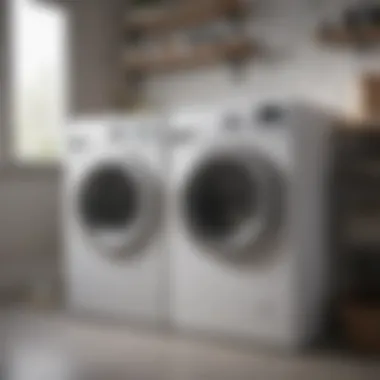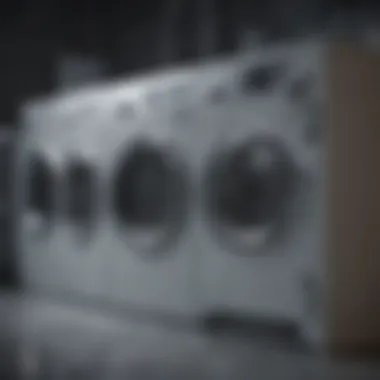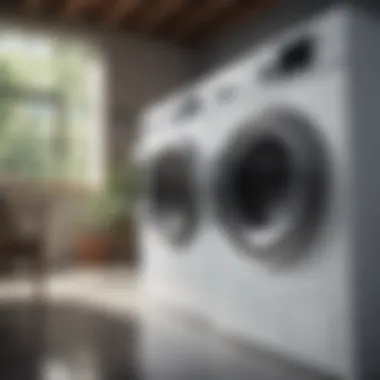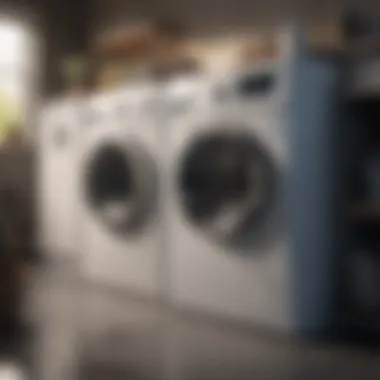Elevate Your Washer's Cleanliness: A Comprehensive Sanitization Guide


Inspiring Homes
When considering the upkeep of our homes, often one crucial appliance that gets overlooked is the washer machine. Maintaining a clean and sanitized washer machine is not only essential for ensuring our clothes come out fresh and clean but also for longevity and efficient performance of the appliance. In this comprehensive guide, we delve deep into the importance of sanitizing your washer machine, exploring practical steps, and recommending products that will help you keep your appliance in prime condition.
Understanding the Importance of Sanitization
Before delving into the actual sanitization process, it is vital to understand why sanitizing your washer machine is crucial. With regular use, washing machines can become breeding grounds for bacteria, mold, and mildew, which can not only lead to foul odors on your laundry but also pose health risks. By disinfecting your washer machine regularly, you not only ensure clean and fresh-smelling clothes but also protect your family's health.
Practical Steps for Effective Sanitization
The process of sanitizing your washer machine involves a few straightforward yet critical steps. Begin by running a hot water cycle with vinegar. Vinegar's acidic nature helps dissolve any built-up soap scum and mineral deposits within the machine, effectively cleaning it. Following this, a second cycle with baking soda helps remove any lingering odors and disinfect the interior. Additionally, wiping down the door seal, detergent drawer, and exterior of the machine with a mild detergent solution can further eliminate germs and bacteria.
Recommended Products for Optimal Performance
While simple home remedies like vinegar and baking soda can work wonders in sanitizing your washer machine, there are specialized cleaning products available in the market that are designed to specifically target bacteria and mold. Look for washing machine cleaning tablets or powders that are formulated to eliminate germs and maintain the efficiency of your appliance. Regular usage of these products can prevent the build-up of grime and ensure your washer machine operates smoothly.
Synthesizing the Information Presented
By following the comprehensive steps outlined in this guide, you can ensure that your washer machine remains clean, sanitized, and in top working condition. Regular maintenance and sanitization not only extend the lifespan of your appliance but also guarantee fresh and odor-free laundry with every wash. Implementing these practices into your cleaning routine will undoubtedly make a significant difference in the performance and longevity of your washer machine.
Understanding the Importance of Washer Machine Sanitization
Sanitizing your washer machine is a crucial aspect of household maintenance that often goes overlooked. In this comprehensive guide on washer machine sanitization, we delve into the significance of keeping your appliance clean and hygienic. By understanding the importance of sanitization, you not only ensure the cleanliness of your laundry but also maintain optimal machine performance for years to come.
Why Sanitizing Your Washer Machine is Essential
Preventing Bacterial Growth:
Sanitizing your washer machine is essential for preventing bacterial growth, which can thrive in damp and warm environments. Bacteria buildup not only leads to unpleasant odors in your laundry but also poses health risks to you and your family. By eliminating bacteria through regular sanitization, you create a hygienic laundry environment and promote overall well-being.
Ensuring Clean Laundry:
A sanitized washer machine guarantees clean and fresh-smelling laundry. Residual bacteria and mold in the machine can transfer onto clothes during each wash cycle, leading to musty odors and potential skin irritation. By prioritizing washer machine sanitization, you ensure that your clothes come out of the wash looking and smelling their best.
Maintaining Machine Longevity:
Regular sanitization not only benefits your laundry but also extends the lifespan of your washer machine. Bacteria and mold growth can cause damage to internal components over time, leading to malfunctions and breakdowns. By incorporating sanitization into your maintenance routine, you contribute to the longevity and efficiency of your appliance.


Signs Your Washer Machine Needs Sanitization
Foul Odors:
One clear sign that your washer machine requires sanitization is foul odors emanating from the appliance or your clean laundry. These odors are a result of bacteria and mildew buildup within the machine, compromising the freshness of your clothes. By addressing and eliminating these odors through sanitization, you can restore a pleasant and clean scent to your laundry.
Visible Mold or Mildew:
The presence of visible mold or mildew in or around your washer machine indicates a significant need for sanitization. Mold spores can spread quickly in moist environments, leading to potential respiratory issues and allergies. By acknowledging and tackling mold growth through thorough sanitization methods, you prevent further contamination and maintain a healthy laundry space.
Residue on Clothes:
Finding residue or stains on your freshly washed clothes is a telltale sign of a dirty washer machine. This residue is often a combination of detergent buildup, mineral deposits, and bacteria, compromising the cleanliness and appearance of your laundry. Through targeted sanitization procedures, you can eliminate residue issues and ensure that your clothes come out of the wash looking pristine and free of contaminants.
Preparing Your Washer Machine for Sanitization
Preparing your washer machine for sanitization is a crucial step in maintaining cleanliness and optimal performance. By ensuring your machine is properly prepared, you can effectively eliminate germs, bacteria, and unwanted residues that may be present. This process not only benefits the cleanliness of your laundry but also contributes to the longevity of your washer machine.
Gathering Necessary Supplies
Bleach or Vinegar
When it comes to choosing between bleach and vinegar for sanitizing your washer machine, both options have their merit. Bleach is a potent disinfectant that can effectively kill germs and bacteria lingering in your machine. On the other hand, vinegar, with its natural acidic properties, can help dissolve mineral buildup and remove soap scum. Both bleach and vinegar are popular choices due to their effectiveness in deep cleaning and sanitization.
While bleach is known for its strong disinfection capabilities, it can be harsh on certain materials and may cause discoloration if not used correctly. On the contrary, vinegar is a milder option that is gentle on most surfaces but may not be as potent in killing bacteria.
Cleaning Cloths
Having quality cleaning cloths is essential for wiping down and scrubbing hard-to-reach areas in your washer machine. The soft texture of cleaning cloths allows you to remove grime and buildup without scratching the surfaces. Opt for lint-free cloths to prevent any fibers from sticking to the machine components during cleaning.
Rubber Gloves
Rubber gloves are a must-have when preparing your washer machine for sanitization. These gloves provide protection for your hands against harsh chemicals present in cleaning agents, such as bleach. Additionally, they offer a better grip when handling wet and slippery surfaces inside the machine, ensuring your safety throughout the cleaning process.
Emptying and Inspecting the Machine
Removing Clothes and Detergent Residue


Before starting the sanitization process, it is crucial to remove any clothes and detergent residue from the washer machine. This step ensures that the cleaning agents can work effectively without interference from other substances. Clearing out the drum and detergent dispensers helps in preventing cross-contamination and allows for a thorough cleaning of all components.
Checking Seals and Dispensers
Inspecting the seals and dispensers of your washer machine is vital to identify any wear and tear that may lead to leaks or issues with the sanitization process. Check for any mold or mildew growth around the seals and clean them thoroughly to prevent further buildup. Ensure that the dispensers are free from clogs and residue to maintain proper detergent flow during wash cycles.
Methods for Sanitizing Your Washer Machine
In this segment of the comprehensive guide on sanitizing your washer machine, we delve into the crucial topic of methods for effectively disinfecting your appliance. The cleanliness and performance of your washer machine heavily rely on how effectively you sanitize it. By comprehensively understanding and implementing proper sanitization methods, you can ensure that your washer remains free from harmful bacteria, molds, and residue build-up. The methods outlined in this guide are essential for maintaining the hygiene and longevity of your washer machine.
Using Bleach for Deep Cleaning
Measuring and Adding Bleach
When it comes to sanitizing your washer machine, utilizing bleach for deep cleaning offers a potent solution. The process of measuring and adding bleach involves precise calculations to ensure the correct dilution for effective disinfection. By following the recommended measurements and adding the bleach to the appropriate detergent dispenser, you can tackle stubborn germs and stains that may have accumulated in your washer. The key characteristic of this method is its strong disinfecting properties, capable of eliminating a wide range of pathogens. While bleach is a popular choice for its germ-killing abilities, it is essential to handle it with care due to its caustic nature. Proper ventilation and protective gear like gloves are recommended when working with bleach to safeguard your skin and respiratory system.
Running a Hot Cycle
After adding bleach to your washer, running a hot cycle is essential to activate its sanitizing effects. The hot water temperature aids in maximizing the disinfecting properties of bleach, ensuring a thorough cleanse of your washer machine. The high heat helps to break down any remaining grime or bacteria in the drum, hoses, and seals of the appliance. Running a hot cycle post-bleach treatment also helps to remove any lingering bleach residue, preventing it from affecting future loads of laundry. While hot cycles are effective for sanitization, they may consume more energy, so it is advisable to balance between optimal hygiene and energy efficiency when performing this cleaning method.
Utilizing Vinegar for Natural Cleaning
Creating a Vinegar Solution
In contrast to bleach, vinegar offers a natural and eco-friendly alternative for cleaning and sanitizing your washer machine. Creating a vinegar solution involves mixing distilled white vinegar with water to produce a cleansing agent with mild acidic properties. Vinegar is renowned for its antibacterial and antifungal qualities, making it a popular choice for eco-conscious individuals seeking a sustainable cleaning solution. The key characteristic of using vinegar is its ability to deodorize, disinfect, and break down mineral deposits within the washer components. While vinegar is gentle on the environment, it may not be as potent as bleach in eliminating tough stains or pathogens, requiring more frequent applications for thorough sanitization.
Running a Cleaning Cycle
Once the vinegar solution is prepared, running a cleaning cycle with vinegar helps to distribute the cleaning agent throughout the washer. The acidity of vinegar aids in removing soap scum, mineral buildup, and mildew that might have accumulated in the machine. Through a complete cleaning cycle, the vinegar can reach all corners of the washer, including hard-to-reach areas where mold or bacteria tend to thrive. Running a cleaning cycle with vinegar on a regular basis can help in maintaining the freshness and hygiene of your washer machine. While vinegar is a safe and natural cleaning agent, it may not be as effective against certain tough stains or deeply embedded grime, requiring additional scrubbing or alternative cleaning methods for optimal results.
Alternative Sanitization Methods
Commercial Washer Cleaners
Apart from bleach and vinegar, commercial washer cleaners offer specialized solutions for deep-cleaning your appliance. These products come in various forms, including powders, tablets, or liquid detergents specifically formulated to target washer odor, residue, and mold. Commercial washer cleaners often contain enzymes or surfactants that can tackle stubborn stains and buildup effectively. The key characteristic of commercial washer cleaners is their convenience and targeted cleaning action, tailored to address specific washer maintenance issues. While these products excel in providing a comprehensive clean, they may be more expensive than traditional cleaning agents, necessitating a cost-benefit analysis based on your cleaning priorities and budget.
Oxygen Bleach Products


Another alternative for sanitizing your washer machine is the use of oxygen bleach products. Oxygen bleach, a non-toxic and environmentally friendly alternative to chlorine bleach, harnesses the power of oxygen ions to break down stains and disinfect surfaces. Oxygen bleach products typically come in powder form and can be mixed with water to form a cleaning solution. The key characteristic of oxygen bleach is its color-safe properties, making it suitable for a wide range of fabrics and colors. While oxygen bleach is gentle on clothes and the environment, it may not be as strong as chlorine bleach in killing certain types of bacteria or molds. Regular use of oxygen bleach products can contribute to maintaining the cleanliness and functionality of your washer machine.
Maintenance Tips to Prevent Future Contamination
In this section on maintenance tips, we delve into the crucial aspects of preventing future contamination in your washer machine. Maintaining a regular cleaning routine plays a pivotal role in ensuring the longevity and efficiency of your appliance. By following proper maintenance practices, you can safeguard against the build-up of bacteria, mold, and residue that can compromise the cleanliness of your laundry. Effective maintenance not only preserves the hygiene of your washer machine but also contributes to the quality of your washed clothes. Implementing these maintenance tips diligently will help in extending the lifespan of your washer machine.
Regular Cleaning Routine
Wiping Down Surfaces
Wiping down surfaces is a fundamental step in maintaining the cleanliness of your washer machine. This practice involves using a suitable cleaning solution to disinfect the exterior and interior surfaces of the machine. By regularly wiping down surfaces, you can prevent the accumulation of grime, dirt, and detergent residue. This ensures that your washer remains free from contaminants that could transfer to your laundry during the wash cycles. Wiping down surfaces not only improves the visual appeal of your washer machine but also enhances its overall hygiene and performance.
Leaving the Door Open
Leaving the door of your washer machine open after each use aids in ventilation and drying. Keeping the door ajar allows air to circulate inside the machine, preventing the formation of musty odors and mildew. This simple practice helps in reducing moisture build-up, which is conducive to the growth of mold and bacteria. By leaving the door open, you facilitate the drying of internal components, inhibiting the conditions for microbial proliferation. Additionally, this practice enhances air circulation within the machine, maintaining a fresh and clean environment.
Proper Detergent Usage
Choosing the Right Detergent
Selecting the appropriate detergent for your laundry needs is essential in ensuring optimal cleaning results. The right detergent helps in effectively removing stains, dirt, and odors from your clothes without causing damage to the fabric or the machine. By choosing a detergent that matches your water hardness level and laundry load size, you can maximize the cleaning efficiency of your washer machine. The correct detergent formulation contributes to maintaining the machine's durability and performance over time.
Using Correct Amounts
Accurately measuring and using the correct amount of detergent for each laundry load is crucial for achieving clean and fresh-smelling clothes. Overloading the machine with excessive detergent can lead to soap residue build-up, compromising the cleanliness of your laundry. Conversely, using too little detergent may result in inadequate cleaning and unpleasant odors in your clothes. By following the manufacturer's guidelines on detergent dosage, you can optimize the washing process, ensuring thorough cleaning while preventing detergent build-up within the machine.
Professional Maintenance Checks
Schedule Annual Inspections
Scheduling annual inspections by a professional technician is a proactive approach to identifying and addressing potential issues with your washer machine. Professional maintenance checks involve assessing the machine's components, identifying wear and tear, and performing necessary repairs or replacements. Regular inspections help in detecting minor problems early, preventing costly breakdowns and malfunctions. By scheduling annual inspections, you can ensure that your washer machine operates efficiently and reliably, maintaining its performance for years to come.
Addressing Issues Promptly
Addressing any operational or performance issues with your washer machine promptly is imperative for minimizing damage and ensuring consistent functionality. Timely intervention in response to unusual sounds, leaks, or malfunctions can prevent further deterioration and escalation of problems. Ignoring or delaying repairs can lead to more extensive damage and higher repair costs in the long run. By promptly addressing issues as they arise, you safeguard the integrity of your washer machine, prolonging its usability and efficiency.
Conclusion
In the extensive realm of washer machine maintenance, the conclusion serves as a vital cornerstone, encapsulating the essence of the meticulous sanitization process. By diligently adhering to the recommendations delineated within this comprehensive guide, one can epitomize the epitome of cleanliness and operational efficiency for their cherished appliance. The zenith of this guide culminates in the amalgamation of various tips, methods, and preventive measures to ensure that your washer machine remains in pristine condition.
As we navigate through the labyrinth of washer machine sanitization, it becomes apparent that a well-maintained appliance not only guarantees hygienic laundry outcomes but also prolongs the longevity of the machine itself. The conclusion is not merely a cessation but a commencement of a continuous cycle of care and maintenance for your washer machine. Emphasizing regular cleaning routines, proper detergent usage, and the significance of professional maintenance checks are crucial facets underscored in this conclusive segment.
Moreover, the importance of prevention over cure reverberates throughout this concluding segment. Proactively safeguarding your washer machine from contamination transcends mere aesthetics; instead, it ensures optimal functionality and operational performance over the long haul. By adopting a proactive stance towards washer machine care, one is fortified with the knowledge and tools necessary to avert potential issues and mitigate the risks that stem from neglected maintenance.
Therefore, in the tapestry of washer machine sanitization, the conclusion assumes a pivotal role by accentuating the symbiotic relationship between conscientious care and machine reliability. Utilizing the insights gleaned from this guide empowers individuals to not only sanitize their washer machines effectively but also instills a sense of pride in ownership and responsibility towards enhancing the appliance's lifespan and efficiency.



